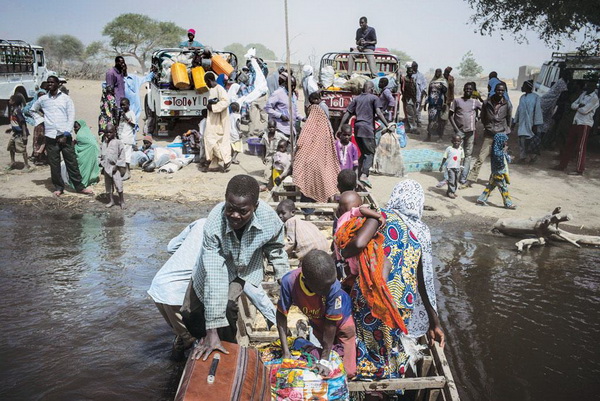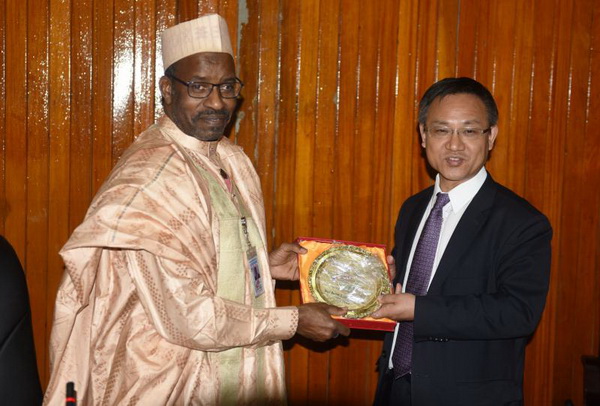


Fishing is a major source of livelihood for millions of people in the Lake Chad Basin. Photo: LCBC
Hopes have been revived for the 40 million people who depend on Lake Chad for their livelihoods following the signing last June in Hangzhou, China, of a deal between Chinese construction giant, PowerChina and the Italian firm, Bonifica Spa. However, the news was only made public at the beginning of this month.
Huge water transfer project
The agreement concerns the carrying out of feasibility studies on transferring 100 billion cubic metres of water per annum from River Congo in the Democratic Republic of Congo, DRC, to replenish the fast shrinking Lake Chad, a distance of 2,500 km. The project is also known as Transaqua. According to the website of Executive Intelligence Review, EIR magazine, the letter of intent was signed at a meeting between the executive of the two companies in the presence of the Italian Ambassador to China, Gabriele Menegatti
The recent deal between PowerChina and Bonifica Spa is sequel to the Memorandum of Understanding, MOU, signed between PowerChina and the Lake Chad Basin Commission, LCBC in the Nigerian capital, Abuja, on December 13, 2016. LCBC is made up of Cameroon, Chad, Niger, Nigeria and the Central African Republic, CAR. The MOU is for a period of four years, but can be extended after renegotiation by both parties.

The Transaqua project seeks to transfer water from River Congo to Lake Chad. Map by Schiller Institute
The agreement is “with a view to setting forth the principles of a technical and financial assistance arrangement towards the actualization of water transfer from the Congo Basin to Lake Chad,” LCBC website reported. PowerChina will fund the studies at the cost of 1.8 million US dollars, while LCBC will provide all necessary information and assistance.
Linking Central and West Africa
The MOU is to establish the basis on which the parties shall carry out further research on the Lake Chad Basin Water Transfer Project and other future projects in accordance with the Lake Chad Basin Water Charter, national legislations, regulations and practices of member countries. Additional research will be needed to strengthen climate change resilience in the Sahel and to raise the project into a continental infrastructure by opening up a new development corridor to link Central and West Africa.
The terms of the agreement between PowerChina and LCBC include the potential transfer of 50 billion cubic metres of water per annum to Lake Chad through a series of dams in DRC, Republic of Congo Brazzaville and the Central African Republic. There is also the possible generation of 15,000-25,000 kilowatts of hydroelectricity through the mass movement of water by gravity.
Other benefits are developing irrigated land for crop and livestock farming covering 50,000-70,000 square km in the Sahel zones of Chad, north-eastern Nigeria, northern Cameroon, and Niger; and providing new infrastructure platform for industries and water transport.
The core idea is to increase the water quantity in Lake Chad, improve water flow conditions, alleviate poverty within the basin through socio-economic activities, meet the energy needs of towns and surrounding areas in DRC and Congo Brazzaville, and conduct in-depth environmental impact assessment studies.

Satellite maps show how fast Lake Chad waters have receded over the past decades. Maps by NASA
New Silk Road to Lake Chad
The Lake Chad Basin Commission resolved the issue of funding studies on water transfer by creating a new Silk Road to Lake Chad. PowerChina, one of the country’s largest multinationals that built the Three Gorges dam, signed a Memorandum of Understanding with LCBC last December.
PowerChina committed to finance the feasibility studies for the initial stages of Transaqua and eventually to build the infrastructure. The water transfer canal will be a navigable facility 100 metres wide and 10 metres deep, stretching from southern DRC to CAR’s northern border. The waterway will be flanked by a service road and eventually a rail line.
Fast-receding lake
Lake Chad, once one of the greatest in the world, has receded fast in recent years as a result of less rainfall and harmful irrigation practices. Other unforeseen phenomena like the exodus of refugees and displaced populations fleeing the atrocities of the Boko Haram terrorist group have since arisen.

The recent deals between PowerChina, LCBC and Bonifica Spa have raised hopes for the 40 million people in the Lake Chad Basin. Photo: LCBC
According to experts, only a robust measure like replenishing the lake’s water could spare the wetland - a food basket located between Central and West Africa - from total disappearance. Meanwhile, the impoverishment of the Lake Chad Basin has made it fertile ground for recruiting terrorists for Boko Haram. Although Transaqua offered a viable solution to the lake’s problems since the 1970s, Western nations and institutions showed little interest in funding the project.
Push by President Buhari
A shift occurred in May 2015 with the election of Nigeria’s President, Muhammadu Buhari. He came to power with a programme to develop national infrastructure, including implementing the water-transfer project for Lake Chad. At several international gatherings, President Buhari made the case for resolving the problems of Lake Chad and requesting Western nations to deliver on promises for financial assistance. He has also strongly oriented his government towards cooperation with BRICS (Brazil, Russia, India, China, South Africa) nations.
Discussing the groundbreaking water agreement in The Nigerian Tribune newspaper last July 25, Nigeria’s Minister of Water Resources, Suleiman Adamu, noted that a similar project to move water from southern to northern China where some areas are semi-arid has been undertaken by the authorities. The Minister added that Nigeria is working with UNESCO to organize an international conference on Lake Chad in Abuja before the end of 2017 to rally support for Transaqua.
Role of LaRouche
Thanks to the fight taken up by LaRouche organization over the years and the initiators of Transaqua, the project is today becoming reality within the framework of the Belt and Road Initiative. Executive Intelligence Review magazine and Schiller Institute in 2015 arranged the first meeting between LCBC and the brains behind Transaqua. This was followed in December 2016 by the signing of the Memorandum of Understanding between LCBC and PowerChina, and subsequent contacts between Bonifica Spa and the Chinese company.

The Boko Haram insurgency has led to the displacement of thousands of people, thereby aggravating the problems in the Lake Chad Basin. Photo: Nigerian Tribune newspaper
Origin of Transaqua project
Transaqua was first developed by the Italian engineering firm, Bonifica, in the late 1970s.
River Congo is the second largest river in the world with an average 41,000 cubic meters of unused water emptied at short intervals into the Atlantic Ocean. Bonifica then estimated that 3-4 per cent of this quantity of unused water will be enough to replenish Lake Chad.
The project involved building of a 2,400 km canal from the southern part of the Democratic Republic of Congo, DRC, (then Zaire) to intercept the right bank tributaries of River Congo through dams and reservoirs, and move 100 billion cubic metres of water per annum by gravity to Lake Chad. The project was given consideration by various stakeholders without much progress because of lack of interest or insufficient funding.

Several meetings were held between PowerChina and LCBC officials. Photo: LCBC
Kimeng Hilton Ndukong, a contributor to People’s Daily Online, is Sub-Editor for World News with Cameroon Tribune bilingual daily newspaper in Cameroon. He is currently a China-Africa Press Centre, CAPC fellow.
 Fire brigade in Shanghai holds group wedding
Fire brigade in Shanghai holds group wedding Tourists enjoy ice sculptures in Datan Town, north China
Tourists enjoy ice sculptures in Datan Town, north China Sunset scenery of Dayan Pagoda in Xi'an
Sunset scenery of Dayan Pagoda in Xi'an Tourists have fun at scenic spot in Nanlong Town, NW China
Tourists have fun at scenic spot in Nanlong Town, NW China Harbin attracts tourists by making best use of ice in winter
Harbin attracts tourists by making best use of ice in winter In pics: FIS Alpine Ski Women's World Cup Slalom
In pics: FIS Alpine Ski Women's World Cup Slalom Black-necked cranes rest at reservoir in Lhunzhub County, Lhasa
Black-necked cranes rest at reservoir in Lhunzhub County, Lhasa China's FAST telescope will be available to foreign scientists in April
China's FAST telescope will be available to foreign scientists in April "She power" plays indispensable role in poverty alleviation
"She power" plays indispensable role in poverty alleviation Top 10 world news events of People's Daily in 2020
Top 10 world news events of People's Daily in 2020 Top 10 China news events of People's Daily in 2020
Top 10 China news events of People's Daily in 2020 Top 10 media buzzwords of 2020
Top 10 media buzzwords of 2020 Year-ender:10 major tourism stories of 2020
Year-ender:10 major tourism stories of 2020 No interference in Venezuelan issues
No interference in Venezuelan issues
 Biz prepares for trade spat
Biz prepares for trade spat
 Broadcasting Continent
Broadcasting Continent Australia wins Chinese CEOs as US loses
Australia wins Chinese CEOs as US loses